Under Review
What is loss of control on an escape?
Turn and Face?
-or
not facing and offensive wrestler cannot regain control
Not facing and out of bounds?
Posted on January 21, 2016 in Control, Escape, General
Under Review
What is loss of control on an escape?
Turn and Face?
-or
not facing and offensive wrestler cannot regain control
Not facing and out of bounds?
Posted on January 21, 2016 in Near-Fall, Scoring
Under Review
Defend-able Base?
-or
Same pinning combination?
-or
Release of hands?
Posted on January 18, 2016 in Communicable Diseases, Ringworm
Posted on January 10, 2016 in Events, Tournament
What a great tournament hosted by Chino Valley High School. A lot of good wrestling, great teams and a fantastic event organized by a top notch crew.
Below is a video of the Northern Arizona Wrestling Officials and Arizona Wrestling Officials Committee.
Posted on January 5, 2016 in Coaches Misconduct, Flagrant Misconduct, Unsportsmanlike Conduct
Note: There is a great article written by wrestlingref.com, and posted here on our site, regarding the difference between coach misconduct or unsportsmanlike conduct.
(NFHS 7-5-n) A coach is permitted to request a conference at the scorer’s table regarding a misapplication of a rule.
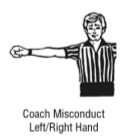
If:
Else:
Remember that Coaches Misconduct can only occur at the scorer’s table. Officials should not continually stop the match to explain everything. “If the coach wants to discuss something in his corner, ask him if he would like to take the discussion to the table. A smart coach is likely to sit down or learn to pick his battles.”
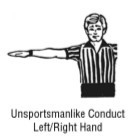
Unsportsmanlike conduct applies to coaches, assistants, wrestlers, trainers and other team personnel, before, during and after a match. A referee must learn to balance the flow of the match, friendly bantering and chirping and unsportsmanlike conduct. As an official, you should be patient and not be influenced by the coach’s comments. If the bantering and chirping becomes disruptive and a constant distraction, the official should penalize someone for Unsportsmanlike Conduct.
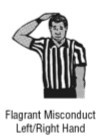 If an argument ensues, the coach could be called for Flagrant Misconduct.
If an argument ensues, the coach could be called for Flagrant Misconduct.
| Type | 1st Instance | 2nd Instance | 3rd Instance |
| Coach Misconduct | Warning | Deduct 1 team point | Deduct 2 team points. Coach is removed for remainder of the day |
| Unsportsmanlike Conduct | Deduct 1 team point | Deduct 2 team points. Coach is removed from competition |
|
| Flagrant Misconduct | Deduct 3 team points. Coach is removed from competition |
Posted on December 30, 2015 in Injury Time
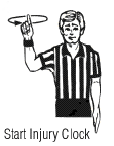 After reading through the 2015-26 Rules Book recently, I was reminded of a couple situations associated with the Injury Time rule.
After reading through the 2015-26 Rules Book recently, I was reminded of a couple situations associated with the Injury Time rule.
Note from NFHS Wrestling Rules: Taking an injury time-out for a non-injury situation is unethical. Coaches should continue to remind their wrestlers of the Code of Ethics found in the Appendix of the NFHS Wrestling Rules Book.
Remember there are several exceptions associated with Injury Time and listed in the Rules Book under Rule 8, Section 2.
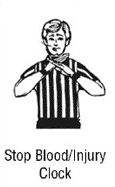
| Injury Time | 1.5 Minutes |
| Recovery Time | 2 Minutes |
| Blood Time | 5 Minutes |
Warning: Watch this video at your own risk. A good example of an accidental injury.
Posted on December 14, 2015 in Full Nelson, Illegal Hold, Locking Hands, Stalling, Technical Violation
Had a great weekend in Kayenta at the Peabody / Monument Valley Wrestling tournament. We had 3 days of wrestling for all ages staring with the little guys that show up as independent to Junior Varsity and High School wrestling in the finals on Saturday night.
This year there were several “themes” that seemed to appear more frequently than last year including:
Stalling
This year, from the NFHS wrestling, one of the Points of Emphasis (POE) is stalling. Kayenta was no exception and we tried to consistently call stalling right away for all ages and all weight classes. As most officials and coaches know, stalling can be a very controversial and a subjective call. As part of AWOC and NAW Officials we try to be as consistent as possible. Remember that the burden for eliminating stalling belongs to the coaches, not to the officials.
There are many definitions of stalling including: To hold off, to delay by evasion, obstructing the flow of play while in the lead… The definition we have discussed with the NAW is… aggressively bettering your position. Be sure to read the definitions from the 2015-2016 rule book as well as the handout on our tools and techniques page.
Penalty Chart for stalling and entering in the score book is: Warning (SW), 1 pt. (S1), 1 pt. (S1), 2 pt. (S2) and Disqualified (DQ)
Locking hands
Locking hands seems to happen a lot at the younger ages and for the less experienced wrestlers. We saw a lot of locking hands this weekend. Remember, that if you are the offensive wrestler and not on 2 feet or not in a pinning situation, you cannot lock your hands. See the Reaction Time discussion in another blog.
Penalty Chart for locking hands and entering in the score book is: Technical Violation, Locking hands 1 pt. (TV1), 1 pt. (TV1), 2 pt. (TV2) and Disqualified (DQ)
Full Nelson
The Full Nelson is an illegal hold and should be called right away. I saw this several times in Kayenta with the younger kids because they are 1) more flexible and 2) are jumping side to side, trying to put in a half nelson. Wrestlers should remove the hand from behind the neck, on one side, before setting the hand on the opposite side for a half nelson. If at any time, both hands are near the center of the neck at the same time, or touching the headgear, you will be called for an illegal hold. The hands do not have to touching or overlapping to be called illegal.
Penalty Chart for full nelson and entering in the scorebook is: Illegal hold 1 pt. (TV1), 1 pt. (TV1), 2 pt. (TV2) and Disqualified (DQ)
Headlocks
Illegal vs. Potential Dangerous. Remember that whenever you are setting a headlock, you must have an arm encircled and you can lock your hands if you are below the elbow. If you are above the elbow or do not have an arm, the match should be stopped right away for an illegal hold. If the defensive wrestler, removes their arm from a legal headlock, then the match can be stopped and the call should be potentially dangerous.
Penalty Chart for illegal headlock and entering in the score book is: Illegal hold 1 pt. (TV1), 1 pt. (TV1), 2 pt. (TV2) and Disqualified (DQ)
I also found this link to a document that wrestlingref.com created that is a nice illustration of some of the moves discussed above.
Posted on November 25, 2015 in Dual Meet, General, Mat Mechanics
This week kicked off the start of the season with a dual meet at Northland Prep Academy on Monday and a multi-team dual on Tuesday at Prescott High School.
The wrestling was great and you can really see those kids that have been practicing all year vs. those that are still working on getting in shape and probably still filling out their school paperwork or getting their grades up to be eligible.
For those coaches that are reading this site, remember to come prepared to weigh-ins with your official team roster. The AIA procedures for weigh-ins are on the AIAonline website as well. The release form for skin lesions can be found here on the AIAonline site.
I wanted to add a few videos of the wrestling/officiating as well. This is mainly instructional only and to help give other officials another perspective on how to call the match.
Take down to a pin!
Locking Hands!
Near Fall!
Stalling!
Liberty vs. Prescott!
Liberty vs. Prescott!
Posted on November 21, 2015 in General, Mat Mechanics
I found a new video recently that seemed very helpful with describing mat mechanics, position, signaling… I feel it is a good refresher video and helpful, especially to new officials, to remember good habits.
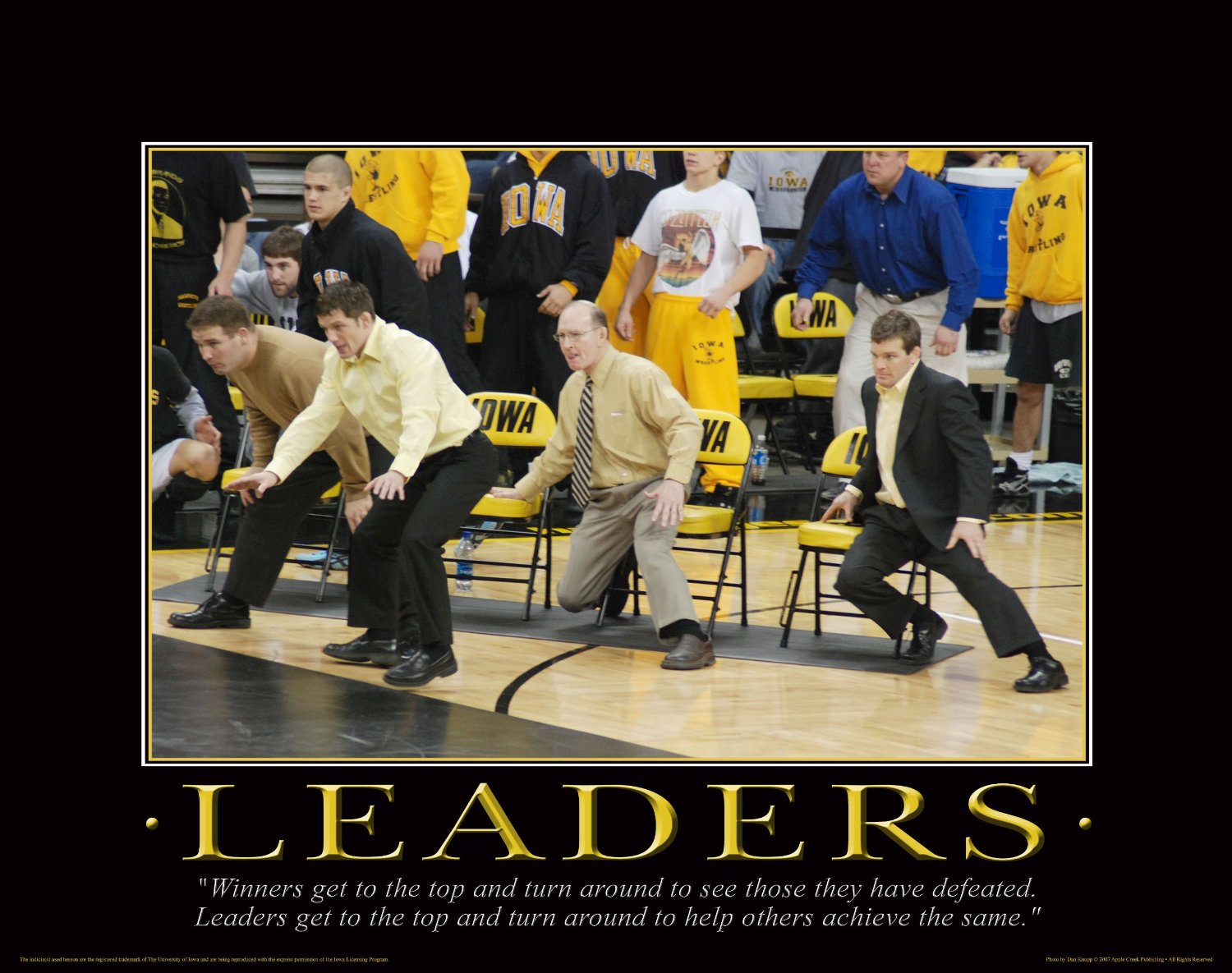
Iowa Wrestling and Leaders
Posted on November 6, 2015 in Meetings, Reaction Time, Work to Improve
Had our officials meeting today and discussed Criteria from the handout at the AWOC meeting. Great discussion, including out-of-bounds, wizzer, take-downs and several others.
What I wanted to comment on in today’s blog was the topics that were scattered through-out the discussion.
Reaction Time:
I reviewed the 2015-2016 NFHS Wrestling Rule Book and found reaction time in the following sections.
Section 10 – Escape: “An escape is when the defensive wrestler gains a neutral position and the opponent has lost control, beyond reaction time…
Section 25 – Takedown: A takedown shall be awarded when one or both knees of the defensive wrestler are touching the mat beyond reaction time… or when the defensive wrestler’s legs or torso are controlled and the majority of the wrestler’s weight is supported by the hands.
Section 3, Article 3 – Interlocking hands: When bringing your opponent to the mat, hands overlapping or interlocking beyond reaction time is a technical violation.
So what is reaction time? Click Here for the definition from senior official, Abel Estrella.
Work to Improve:
This is also a great topic because it has multiple meanings. When wrestling, to avoid a stalemate and stalling, and something all wrestlers should be constantly doing is, “Work to Improve”. Failing to do so can impact a wrestler in a negative way. Wrestlers should always be working to improve.
Note that this is different but similar to the term, “improve his/her position” mentioned in the rule book. For example, if the offensive wrestler is utilizing the body scissors to improve his/her position… the maneuver is being properly executed.
Or
Section 23 – Stalemate: It Is a stalemate when contestants are interlocked in a position other than a pinning situation, in which neither wrestler can improve their respective position(s).
Just some thoughts for the day for those officials that hear these terms and are processing their respective definitions.